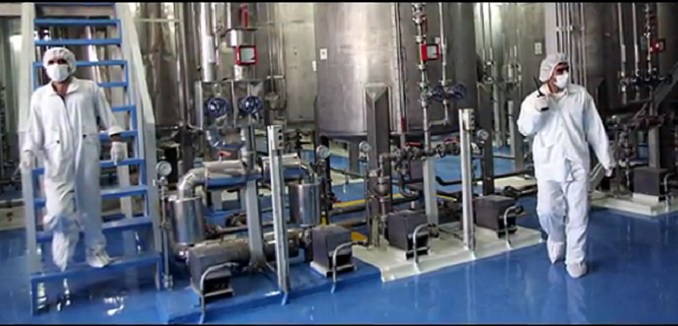A top official linked to Iran’s atomic agency bragged this week that a critical uranium-related concession made by Tehran under the interim Joint Plan of Action (JPA) could be reversed in a matter of weeks, part of a broader speech that included boasts about the quality of new Iranian centrifuges – a twentyfold increase in enrichment capacity – and the creation of new Russian-built energy plants:
Atomic Energy Organization of Iran (AEOI) spokesman Behrouz Kamalvandi announced “Oxidizing 5% uranium does not mean the elimination of uranium… It is a mistake to say that we lose our reserves by oxidizing uranium…We can transform our 5% uranium to 20% within two to three weeks if needed.”
Sohrab Ahmari, an Iranian-born editorial page writer for The Wall Street Journal Europe, bluntly assessed the speech as a statement that the Iranian regime views the JPA as a deal in which “all the advantages accrue to Tehran.”
The JPA requires Iran to turn portions of its 5 percent and 20 percent pure uranium stockpiles into uranium oxide, temporarily preventing that stock from being enriched further. Regarding its 20 percent stockpile, Iran is obligated to either dilute the material back down to 5 percent (“downblending”) or to oxidize it at 20 percent. Regarding its 5 percent stockpile, Iran is obligated to ensure that – at the end of the JPA’s six-month negotiation period – there is only as much of that stock on hand as there was at beginning of the deal’s implementation. Iran is permitted unlimited enrichment to 5 percent, but the new material that’s created has to be oxidized until the total amount of 5 percent pure stock is equal to what it was when the JPA period began.
The deal was touted by the Obama administration as putting “time on the clock” by “freezing” the Iranian nuclear program, ensuring Tehran could not use the negotiation period to inch closer to creating 90 percent enriched weapons-grade uranium. Skepticism regarding the robustness of the JPA emerged in the days immediately following the announcement agreement, was sharpened by what appeared to be several places in which the administration had either misunderstood or misled the public about Iranian obligations, and will be fueled further by Kamalvandi’s comments.
His remarks about the enrichment capacity of next-generation centrifuges are likely to prove particularly problematic, inasmuch as Iran controversially maneuvered the West into allowing continued development of advanced centrifuges under the JPA. A report published last week by the International Atomic Energy Agency (IAEA) introduced an additional complication, revealing that the commissioning of a facility designed to convert 5 percent enriched gas into oxide – this is the facility that was supposed to ensure that Iran stayed under the JPA’s cap for un-oxidized uranium, even as its scientists continued to enrich unlimited amounts of the material – had been put off. No reason was given for the delay.
Kamalvandi’s remarks will in any case be seen as underscoring that the JPA may well leave Iran with more enriched uranium and with more centrifuges, which will themselves be more advanced than previous technology. Should the conversion facility finally open, the difference will be that the additional enriched material will be in oxide form.
Mark Hibbs, writing on the Arms Control Wonk blog partially sponsored by the left-leaning Ploughshares Fund, had already pointed out last April that Iran could use existing facilities to reverse the oxidization process, and that such reconversion would only take a few weeks:
Experience from the uranium conversion industry and R&D sector outside Iran would suggest that Iran might be able to convert about 100 kg of U3O8 to UF6 in about two weeks–provided, however, that the work was carried out in a small facility using a dry process without purification, whereby perhaps three batches would be consecutively processed. Use of other processes and a larger installation might lengthen the time required to reconvert the material. Regardless of whether Iran would select a wet or dry process, the most time-critical process step would likely be the production of UF4 from UO2 because of the comparatively slow reaction time for AHF and UO2.
[Photo: Today Breaking News / YouTube]




